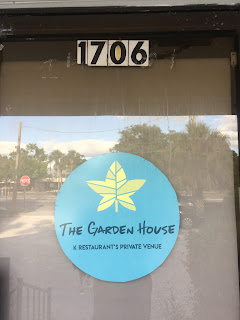Silvia who, in addition to her ownership role, also functions as the Marketing and Sales Director, Financial Director, and Winemaker, was supposed to lead our tour but had to change her plans. Instead she deputized Jacopo Maniaci (Winery Director, Hospitality Manager, Sommelier, Cellar Master, and Export Ambassador) for that role. He performed admirably.
Jacopo met us on arrival and led us on to a platform overlooking the vineyard. The sun was setting in the distance and lit the vineyard and surrounding structures up with a soft, golden glow.
 |
| With Jacopi on the platform overlooking the Tenuta di Fessina vineyard in Rovitello |
Tenuta di Fessina, Jacopo said, has three vineyards on Mt Etna -- located on the north, east, and south slopes of the mountain -- and a fourth in Val di Noto that produces the grapes for the estate's Nero d'Avola wine. The map below shows the location (precise in the Rovitello case) and key characteristics of the estate's Mt. Etna vineyards.
 |
Tenuta di Fessina vineyards in the
Mt Etna region
|
Fessina's main vineyard (estate-owned) is located in Contrada Moscamento (Muscamento in the dialect) in the commune of Rovitello. The vineyard is framed by two slopes: the one on the left was formed by the flow from the 1911 eruption while the one on the right was formed in 1809. These are relatively young structures and serve primarily as vineyard protection. The actual vineyard soil predates these two flows, dating back to between 4000 and 15,000 years ago, and is comprised of pumice and light sand enriched with iron, copper, manganese, and potassium. Soil depth ranges between 10 and 12 meters.
The vineyard is the beneficiary of breezes blowing in form the Ionian Sea and, as a result, is pest-free. Sulphur and copper are used to combat mildew. Vines are trained Alberello and have an average age of 70 years. Ten different Nerello Mascalese biotypes exist within the environment.
The sandy nature of the soil has rendered it phylloxera-free. As a result, most of the vines are own-rooted. Nerello Capuccio scions are, however, grafted onto Nerello Mascalese rootstocks. White grape varieties are found in specific sections within the vineyard. Vine replacement is by massal selection.
 |
| Jacopo responding to a question from Sue Tolson |
 |
| Old vines |
At the conclusion of our visits to the vineyards and cellars we repaired to the tasting room to sample some of the estate's wares.
 |
| Wayne Young and Sue Tolson prepare for the tasting segment of our tour |
The first wine tasted was the 2016 Erse Etna Bianco DOC, a blend of 90 % Carricante, 8% Cataratto, and the remainder Minella. The grapes are sourced from Milo. Jacopo characterized 2016 as a rigid and cold vintage in Milo. The wine is fermented in stainless steel and aged for 9 months in bottle. The wine showed mineral, spice, salinity, flint, and an oily richness on the nose. A great palate with minerality, a lean salinity, good acid levels, and a long finish.
We next tasted three vintages of A'Puddara, a 100% Carricante made with grapes sourced from the commune of Santa Maria di Licodia on the south slope of the mountain. The 2016 vintage showed minerality, matchstick, nuttiness, and sweet, ripe fruit. Lime on the palate. Not very fulfilling.
The 2015 edition of this wine showed minerality, matchstick, a duskiness, and herbs on the nose and acidity without the balancing salinity on the palate. Jacopo said that 2015 had been a very difficult vintage in that it was colder and the picked grapes had less sugar content. The wines had not been subjected to malolactic fermentation, hence the elevated acid levels.
The 2011 growing season was warm and the wine of this label showed a creamy richness, salinity, minerality, matchstick, and ripe tropical fruit.
The 2017 Erse Etna Rosato DOC is a blend of Nerello Mascalese and Nerello Cappuccio (30%) with the latter variety added to provide color and "honey, fruity notes." This wine is aged on the lees for 7 months and an additional 2 - 3 months in bottle before release on the market. A bright pink color. Reduced nose initially but that quickly blew off to reveal a fruitiness. Salinity and power on the palate.
The 2017 Laeneo Nerello Cappucchio (100%) was very aromatic. Fruitiness and spice on the nose. More refined and elegant than most of the 100% Nerello Cappuccios that I had tasted previously.
The 2015 Erse Etna Rosso DOC was made from 90% Nerello Mascalese, 8% Nerello Cappuccio, and 2% white grape varieties, all sourced from the Rovitello vineyard. This wine was fermented in stainless steel and aged therein for 9 months. Shoe polish, florality, and cherry on the nose and spicy red fruit on the palate. Elegant and persistent while exercising the salivary glands. Drying finish.
The final battery of wines was drawn from the Musmeci Etna DOC Rosso Riserva label: 2012, 2011, and 2007. The 2012 was perfumed, elegant, and feminine. Red fruit and great acidity on the palate. Engaging. The 2011 showed menthol, balsamic, and green herbs on the nose. Started slow but then exploded on the palate. A piney character. Excellent fruit on the 2007. Slightly medicinal. Excellent body and persistence.
High-quality wines from a high-quality producer with high-quality staff.
©Wine -- Mise en abyme














































